Multi-Target CFAR Detection Method for HF Over-The-Horizon Radar Based on Target Sparse Constraint in Weibull Clutter Background
Abstract
:1. Introduction
2. Basic Theory
2.1. RD Spectrum Statistical Characteristics of High-Frequency Over-The-Horizon Radar
2.2. OS-CFAR Principle
2.3. Parameter Estimation Method Based on Jamming Target Regularization
2.3.1. Regularization of the Jamming Target
2.3.2. Shape Parameter Estimation
2.4. Correction of the k Value
3. Simulation Results and Actual Measurement Verification
3.1. Convergence Analysis of the Shape Parameter Estimation Algorithm
3.2. Error Analysis of the Shape Parameter Estimation
3.3. Jamming Target Recognition Performance
3.4. Value Analysis of K
3.5. Algorithm Performance Evaluation
3.6. Actual Measurement Verification
4. Conclusions
Author Contributions
Funding
Data Availability Statement
Conflicts of Interest
Abbreviations
| High Frequency | HF |
| Over-the-Horizon Radar | OTHR |
| Range–Doppler | RD |
| Azimuth–Range–Doppler | ARD |
| Ordered Statistics | OS |
| Constant False Alarm Rate Detector | CFAR |
| Cell Under Test | CUT |
| Cell-Averaging | CA |
| Censored Cell-Averaging | CCA |
| Ordered Data Variability | ODV |
| Gamma | GM |
| Weighted Amplitude Iteration | WAI |
| Generalized Likelihood Ratio | GLR |
| Linear Discriminant Analysis | LDA |
| Matrix Information Geometry | MIG |
| High Frequency Surface Wave Radar | HFSWR |
| Signal-to-Noise Ratio | SCR |
| Detection Probability | Pd |
| False Alarm Probability | Pfa |
| Based Regularization and Correction Ordered Statistics | BRACOS |
| Ordered Statistic with Greatest Option | OSGO |
| Maximum Likelihood | MLH |
References
- Joo, K.Y.; Keol, W.S.; Sungho, P.; Yong, S.S.; Hui, J.Y.; Eunjung, Y. OS CFAR Computation Time Reduction Technique to Apply Radar System in Real Time. J. Korean Inst. Electromagn. Eng. Sci. 2018, 29, 791–798. [Google Scholar]
- Zhen, J. Multi-target CFAR Detection of a Digital Phased Array Radar System. J. Phys. Conf. Ser. 2019, 1314, 012011. [Google Scholar]
- Raghavan, R.S. CFAR Detection in Clutter with a Kronecker Covariance Structure. IEEE Trans. Aerosp. Electron. Syst. 2017, 53, 619–629. [Google Scholar] [CrossRef]
- Palamà, R.; Greco, M.; Gini, F. Multistatic adaptive CFAR detection in non-Gaussian clutter. EURASIP J. Adv. Signal Process. 2016, 2016, 17. [Google Scholar] [CrossRef]
- Thabit, A.A.; Ziboon, H.T. Improving Probability of Detection using CFAR and Adaptive Threshold for Cognitive Radio (CR). Int. J. Eng. Adv. Technol. 2015, 4, 5. [Google Scholar]
- Sen, L.; Xin, B.; Libo, H.; Bin, T. 2-D CFAR Procedure of Multiple Target Detection for Automotive Radar. SAE Int. J. Passeng. Cars Electron. Electr. Syst. 2017, 11, 67–75. [Google Scholar]
- Hatem, G.M.; Saeed, T.R.; Sadah, J.W. Comparative Study of Combined CFAR Algorithms for Non-Homogenous Environment. Procedia Comput. Sci. 2018, 131, 58–64. [Google Scholar] [CrossRef]
- Barboy, B.; Lomes, A.; Perkalski, E. Cell-Averaging Cfar for Multiple-Target Situations. IEE Proc. F Radar Signal Process. 1986, 133, 176–186. [Google Scholar] [CrossRef]
- Ozgunes, I.; Gandhi, P.P.; Kassam, S.A. A Variably Trimmed Mean Cfar Radar Detector. IEEE Trans. Aerosp. Electron. Syst. 1992, 28, 1002–1014. [Google Scholar] [CrossRef]
- Smith, M.E.; Varshney, P.K. Intelligent CFAR processor based on data variability. IEEE Trans. Aerosp. Electron. Syst. 2000, 36, 837–847. [Google Scholar] [CrossRef]
- Himonas, S.D.; Barkat, M. Automatic Censored Cfar Detection for Nonhomogeneous Environments. IEEE Trans. Aerosp. Electron. Syst. 1992, 28, 286–304. [Google Scholar] [CrossRef]
- Farrouki, A.; Barkat, M. Automatic censoring CFAR detector based on ordered data variability for nonhomogeneous environments. IEE Proc. Radar Sonar Navig. 2005, 152, 43–51. [Google Scholar] [CrossRef]
- Zaimbashi, A.; Norouzi, Y. Automatic dual censoring cell-averaging CFAR detector in non-homogenous environments. Signal Process. 2008, 88, 2611–2621. [Google Scholar] [CrossRef]
- Abimouloud, M.; Baadeche, M.; Soltani, F. CFAR Detection Performance in Weibull Clutter for Statistical MIMO Radar Using Fuzzy Fusion Rules. J. Commun. Technol. Electron. 2022, 66 (Suppl. S2), S118–S125. [Google Scholar] [CrossRef]
- Zhang, B.; Zhou, J.; Xie, J.; Zhou, W. Weighted likelihood CFAR detection for Weibull background. Digit. Signal Process. 2021, 115, 103079. [Google Scholar] [CrossRef]
- Xu, Y.; Hou, C.; Yan, S.; Li, J.; Hao, C. Fuzzy statistical normalization CFAR detector for non-rayleigh data. IEEE Trans. Aerosp. Electron. Syst. 2015, 51, 383–396. [Google Scholar] [CrossRef]
- Xu, Y.; Yan, S.; Ma, X.; Hou, C. Fuzzy soft decision CFAR detector for the K distribution data. IEEE Trans. Aerosp. Electron. Syst. 2015, 51, 3001–3013. [Google Scholar] [CrossRef]
- Meng, X.W. Performance Analysis of OS-CFAR with Binary Integration for Weibull Background. IEEE Trans. Aerosp. Electron. Syst. 2013, 49, 1357–1366. [Google Scholar] [CrossRef]
- Kong, L.; Wang, B.; Cui, G.; Yi, W.; Yang, X. Performance Prediction of OS-CFAR for Generalized Swerling-Chi Fluctuating Targets. IEEE Trans. Aerosp. Electron. Syst. 2016, 52, 492–500. [Google Scholar] [CrossRef]
- Zhou, W.; Xie, J.; Li, G.; Du, Y. Robust CFAR Detector with Weighted Amplitude Iteration in Nonhomogeneous Sea Clutter. IEEE Trans. Aerosp. Electron. Syst. 2017, 53, 1520–1535. [Google Scholar] [CrossRef]
- Santamaria, I.; Scharf, L.L.; Ramírez, D. Scale-Invariant Subspace Detectors Based on First- and Second-Order Statistical Models. IEEE Trans. Signal Process. 2020, 68, 6432–6443. [Google Scholar] [CrossRef]
- Hua, X.; Peng, L.; Liu, W.; Cheng, Y.; Wang, H.; Sun, H.; Wang, Z. LDA-MIG Detectors for Maritime Targets in Nonhomogeneous Sea Clutter. IEEE Trans. Geosci. Remote Sens. 2023, 61, 5101815. [Google Scholar] [CrossRef]
- Weinberg, G.V. Coherent CFAR detection in compound Gaussian clutter with inverse gamma texture. EURASIP J. Adv. Signal Process. 2013, 2013, 105. [Google Scholar] [CrossRef]
- Zhang, R.; Sheng, W.; Ma, X. Improved switching CFAR detector for non-homogeneous environments. Signal Process. 2013, 93, 35–48. [Google Scholar] [CrossRef]
- Beklaouz, H.L.; Hamadouche, M.H.; Mimi, M.; Taleb-Ahmed, A. CFAR Detection in the Framework of Time-Frequency Analysis. Int. Rev. Electr. Eng. IREE 2016, 11, 323–330. [Google Scholar] [CrossRef]
- Aalo, V.A.; Peppas, K.P.; Efthymoglou, G. Performance of CA-CFAR detectors in nonhomogeneous positive alpha-stable clutter. IEEE Trans. Aerosp. Electron. Syst. 2015, 51, 2027–2038. [Google Scholar] [CrossRef]
- Zaimbashi, A. An adaptive cell averaging-based CFAR detector for interfering targets and clutter-edge situations. Digit. Signal Process. 2014, 31, 59–68. [Google Scholar] [CrossRef]
- Maresca, S.; Greco, M.; Gini, F.; Grasso, R.; Coraluppi, S.; Thomas, N. The HF Surface Wave Radar WERA. Part I: Statistical Analysis of Recorded Data. In Proceedings of the IEEE Radar Conference, Arlington, VA, USA, 10–14 May 2010; pp. 826–831. [Google Scholar]
- Shang, S. Study on Statistical Characteristics of Ionospheric Clutter in High Frequency Ground Wave Radar. J. Radio Wave Sci. 2011, 26, 7. [Google Scholar]
- Yang, L. Constant false alarm rate detector based on sparsity regularisation in multi-target interfering Weibull clutter. IET Radar Sonar Navig. 2019, 13, 573–583. [Google Scholar] [CrossRef]
- Shor, M.; Levanon, N. Performance of order statistics CFAR. IEEE Trans. AES 1991, 27, 214–224. [Google Scholar] [CrossRef]
- Forero, P.A.; Kekatos, V.; Giannakis, G.B. Robust clustering using outlier-sparsity regularization. IEEE Trans. Signal Process. 2012, 60, 4163–4177. [Google Scholar]
- Selesnick, I.W.; Bayram, I. Enhanced Sparsity by Non-Separable Regularization. IEEE Trans. Signal Process. 2016, 64, 2298–2313. [Google Scholar] [CrossRef]
- Selesnick, I.; Farshchian, M. Sparse Signal Approximation via Nonseparable Regularization. IEEE Trans. Signal Process. 2017, 65, 2561–2575. [Google Scholar] [CrossRef]
- Hongxia, L. Analysis and MATLAB Simulation of Radar Signal Digital Pulse Compression Technology. Informatiz. Res. 2018, 44, 69–73. [Google Scholar]
- Tianci, Q.; Zhongxun, W.; Yong, H.; Ningbo, L.; Hao, D. An OS-CFAR detector with corrected k-value. Electron. Technol. Appl. 2022, 48, 5–38. [Google Scholar] [CrossRef]
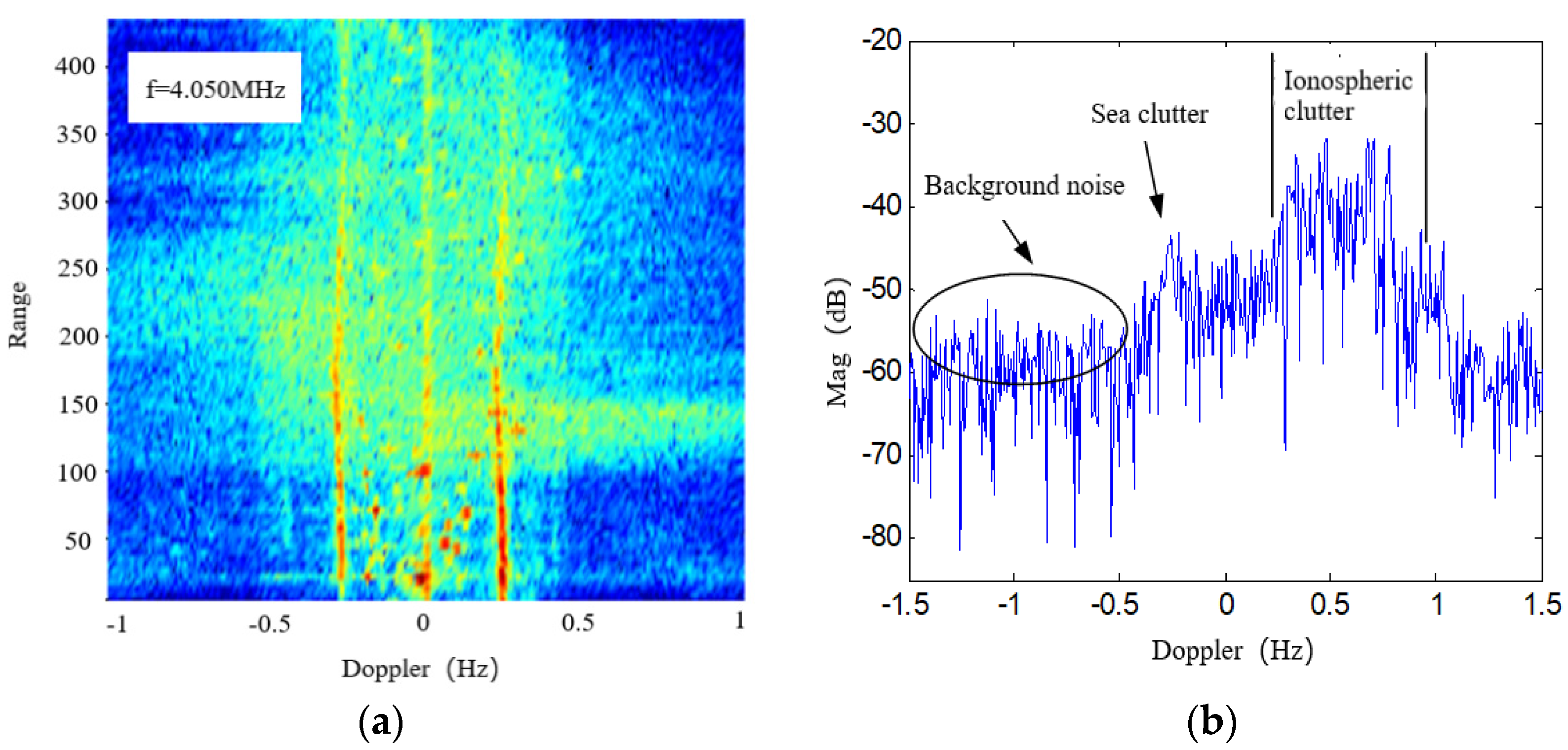
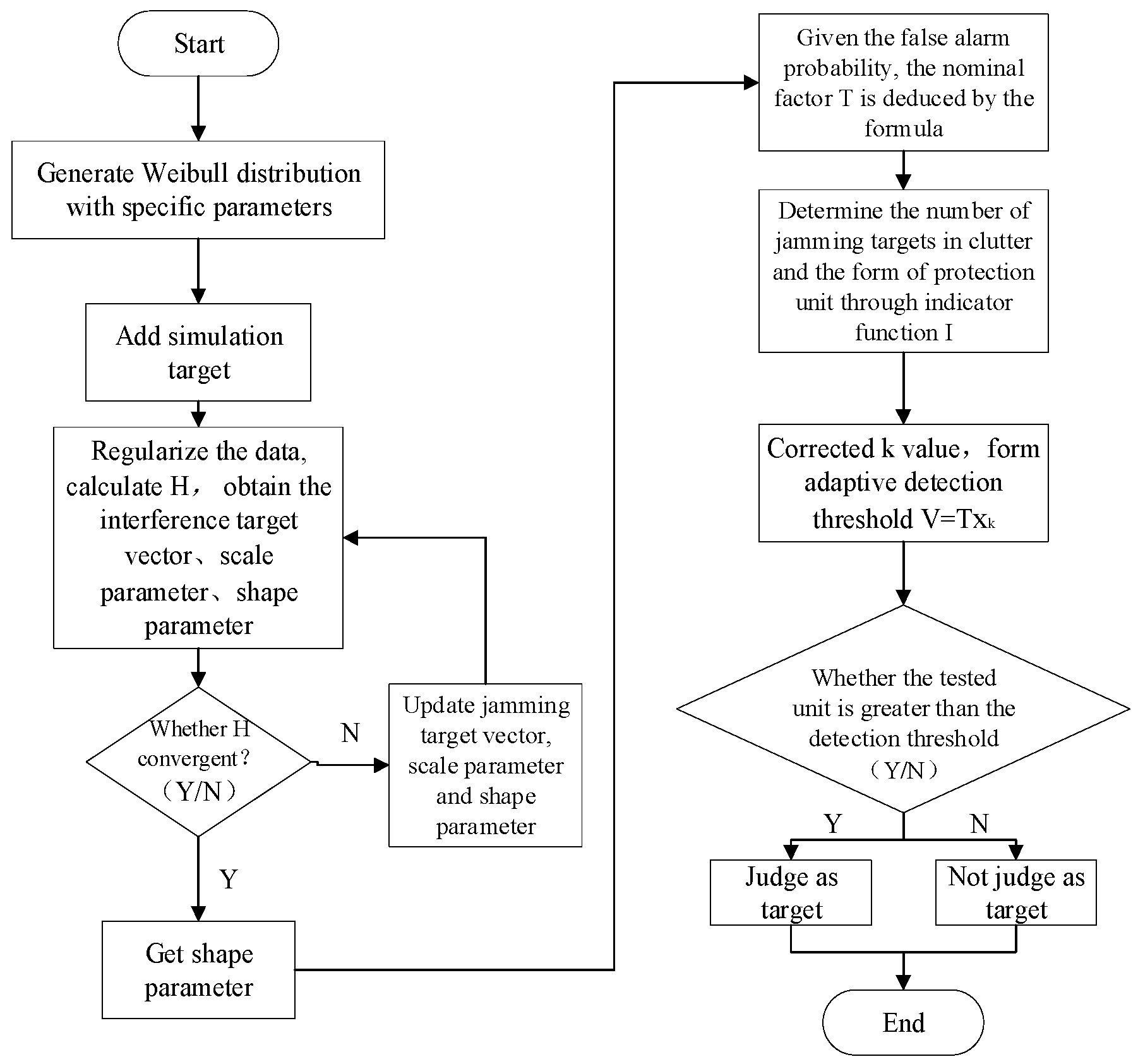
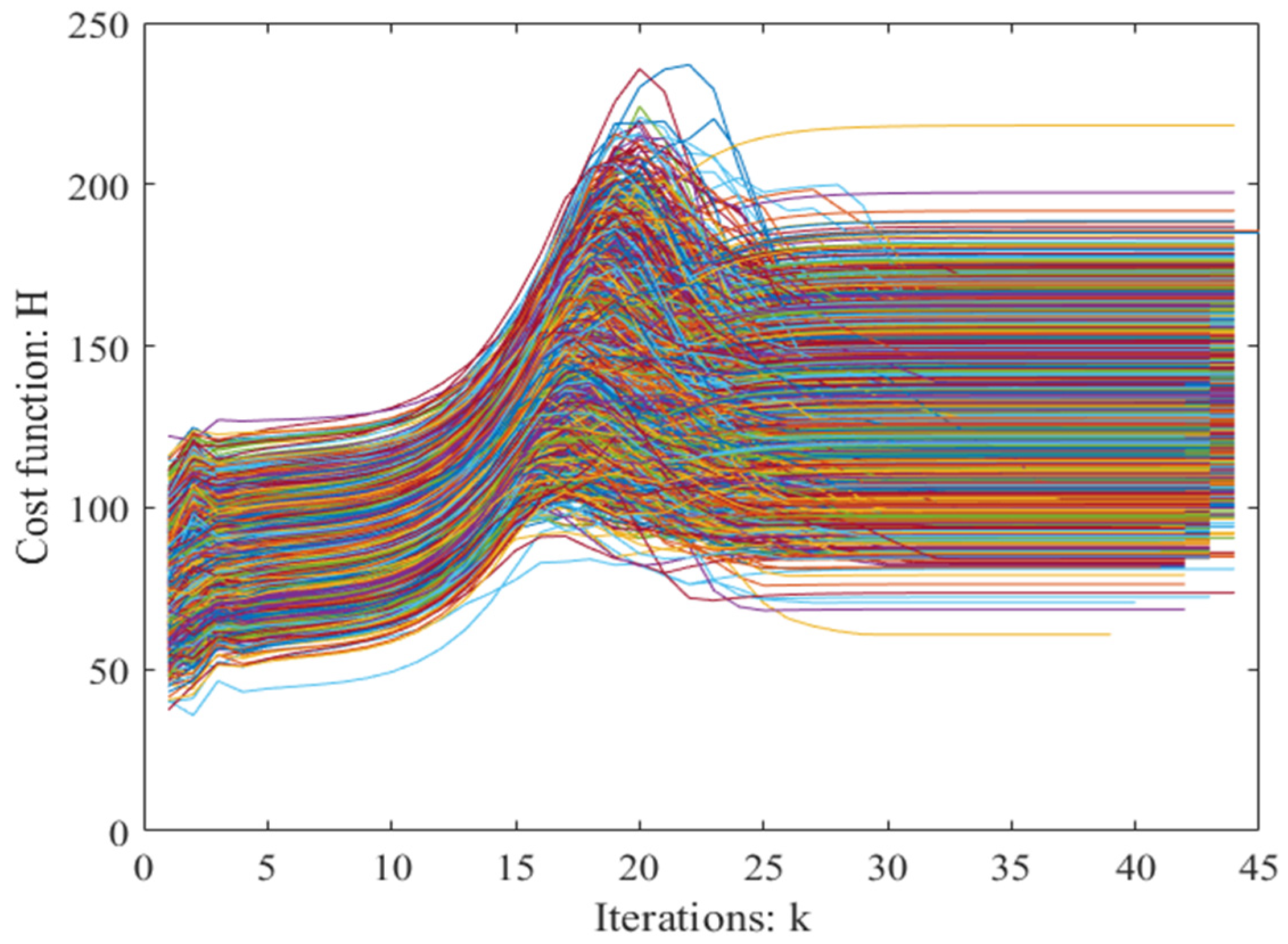




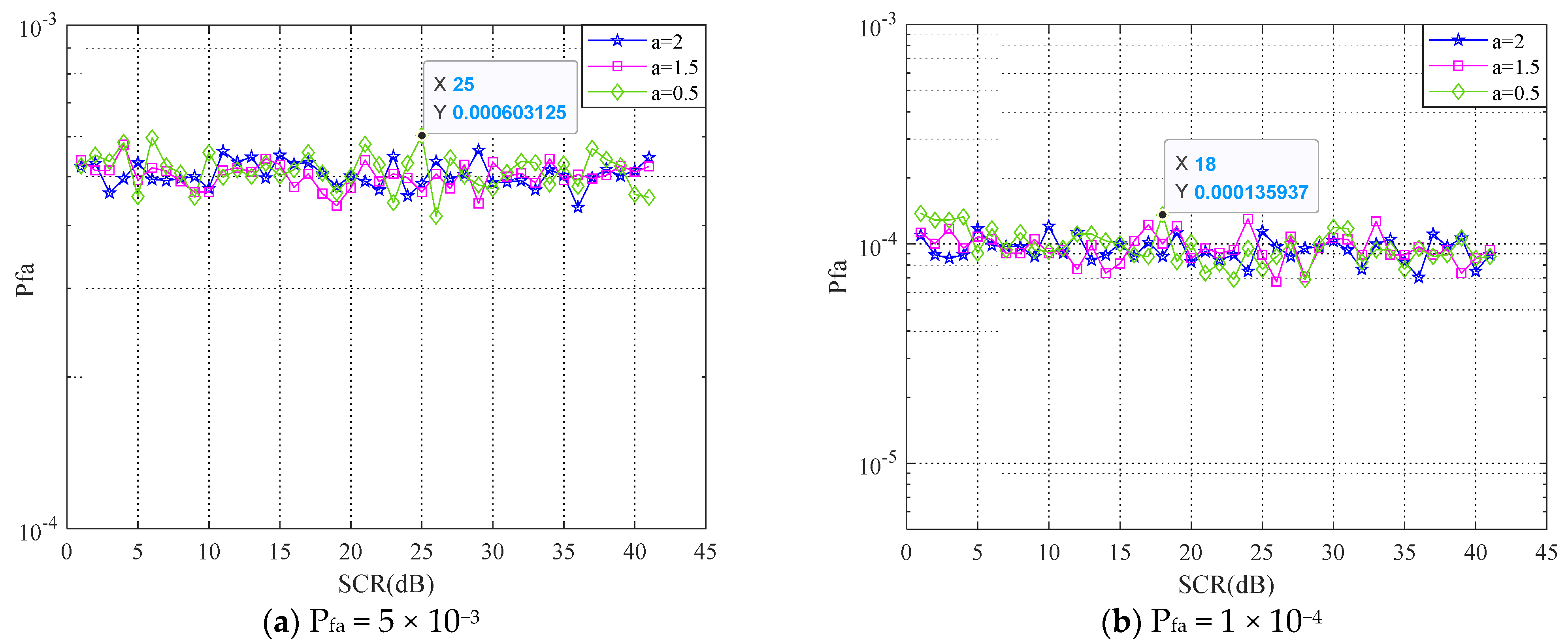
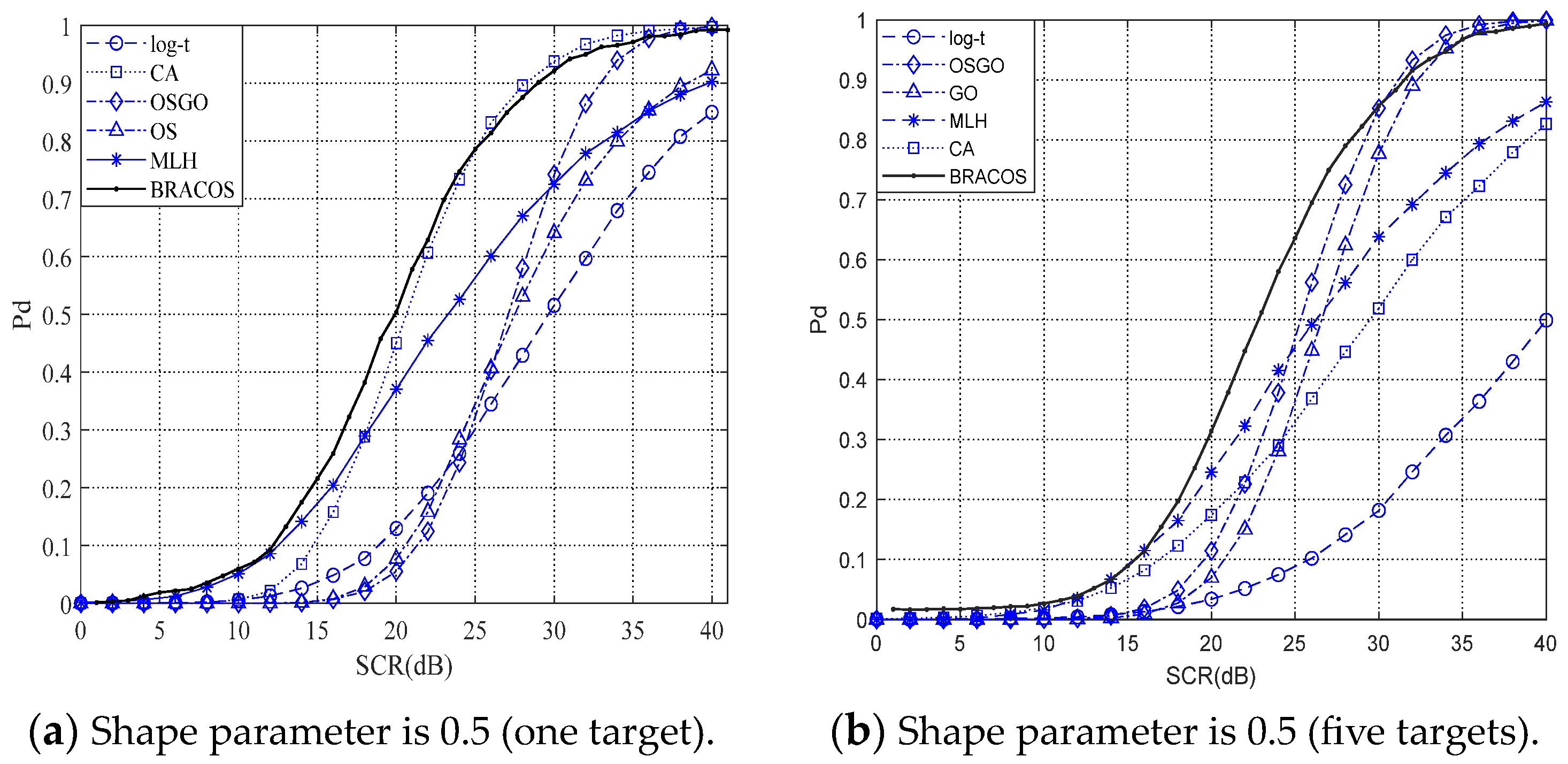

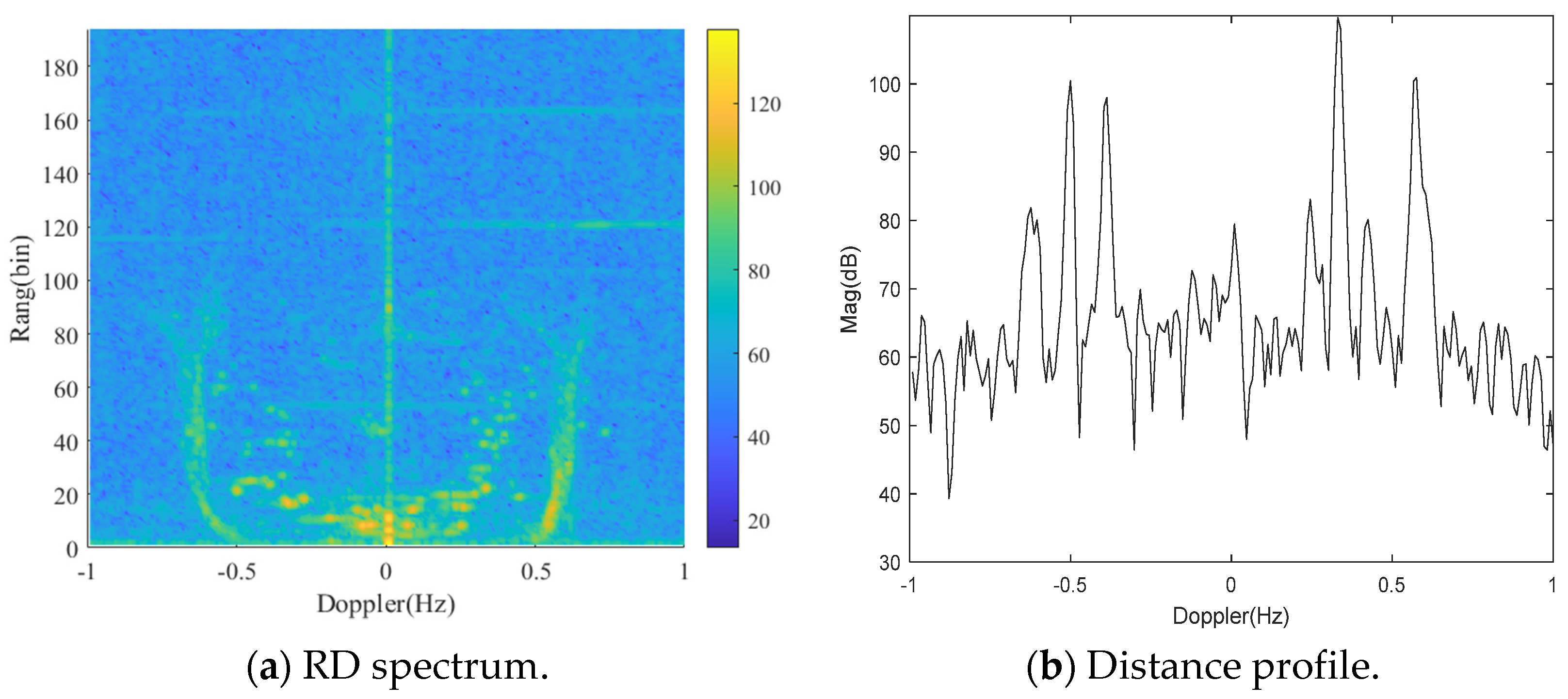
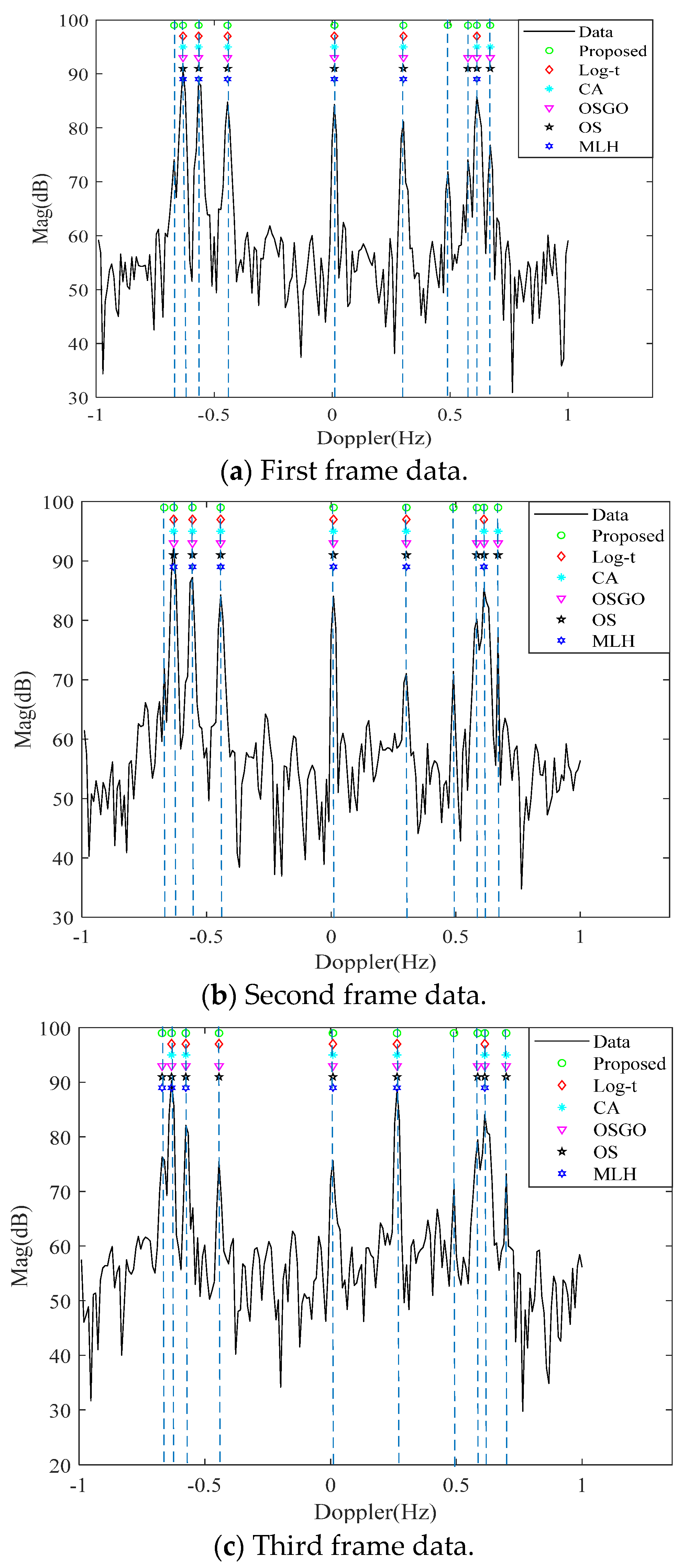
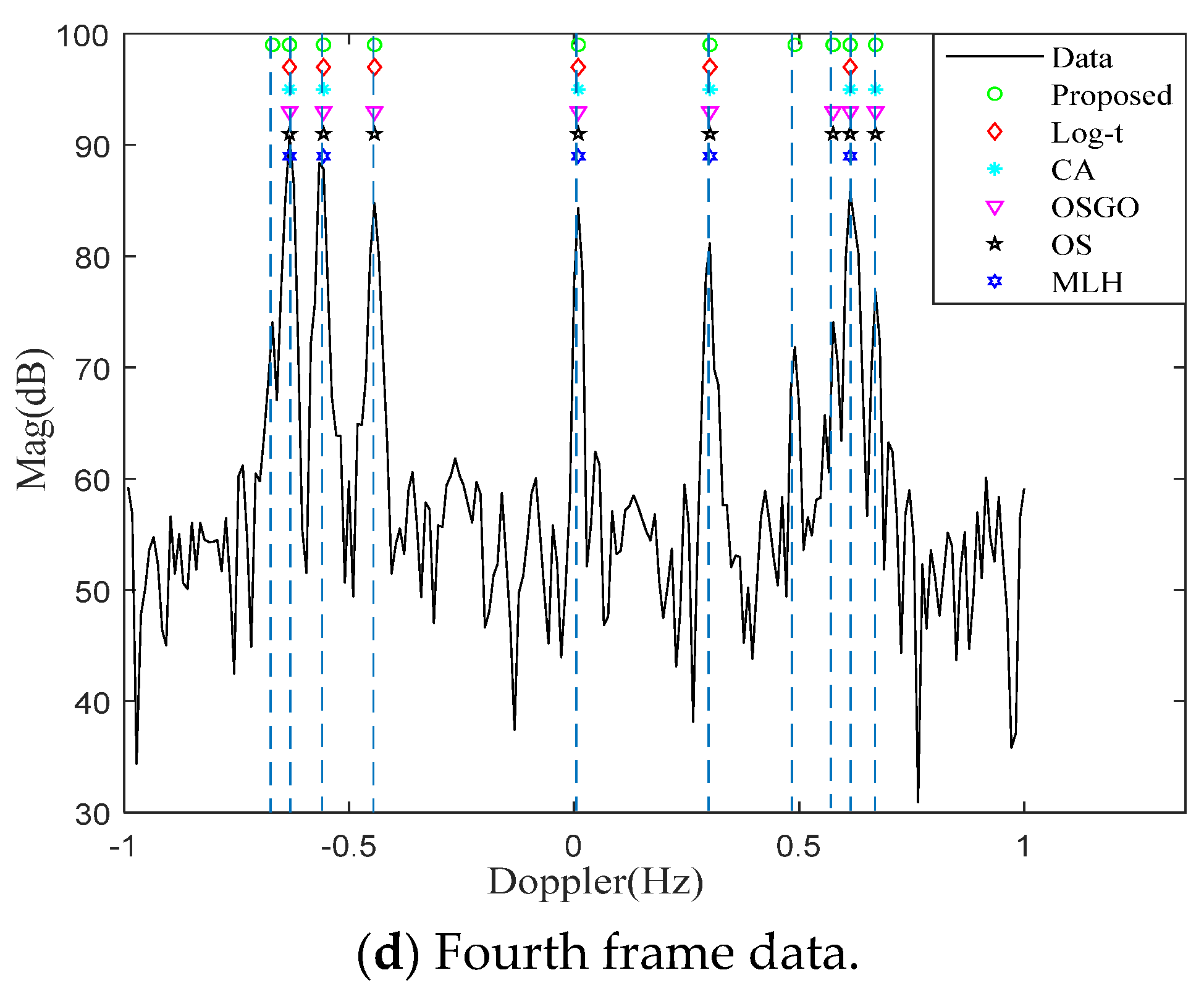
| Shape Parameter Estimation Algorithm Based on Jamming Target Elimination |
|---|
| Input: , |
| Output: |
| Initialization: |
| 2: do |
| is Calculated by (19) 4: is Calculated by (16) |
| is Calculated by (20) |
| 6: is Calculated by (21) |
| While (14) does not converge |
Disclaimer/Publisher’s Note: The statements, opinions and data contained in all publications are solely those of the individual author(s) and contributor(s) and not of MDPI and/or the editor(s). MDPI and/or the editor(s) disclaim responsibility for any injury to people or property resulting from any ideas, methods, instructions or products referred to in the content. |
© 2023 by the authors. Licensee MDPI, Basel, Switzerland. This article is an open access article distributed under the terms and conditions of the Creative Commons Attribution (CC BY) license (https://creativecommons.org/licenses/by/4.0/).
Share and Cite
Zhang, W.; Li, Y.; Zheng, Z.; Xu, L.; Wang, Z. Multi-Target CFAR Detection Method for HF Over-The-Horizon Radar Based on Target Sparse Constraint in Weibull Clutter Background. Remote Sens. 2023, 15, 2488. https://doi.org/10.3390/rs15102488
Zhang W, Li Y, Zheng Z, Xu L, Wang Z. Multi-Target CFAR Detection Method for HF Over-The-Horizon Radar Based on Target Sparse Constraint in Weibull Clutter Background. Remote Sensing. 2023; 15(10):2488. https://doi.org/10.3390/rs15102488
Chicago/Turabian StyleZhang, Wenhao, Yajun Li, Zhengqi Zheng, Lin Xu, and Zhicheng Wang. 2023. "Multi-Target CFAR Detection Method for HF Over-The-Horizon Radar Based on Target Sparse Constraint in Weibull Clutter Background" Remote Sensing 15, no. 10: 2488. https://doi.org/10.3390/rs15102488






